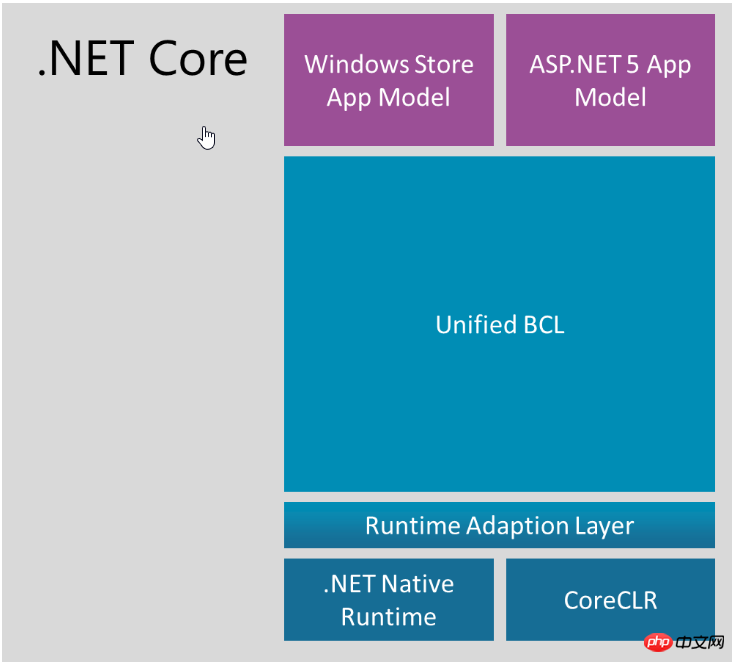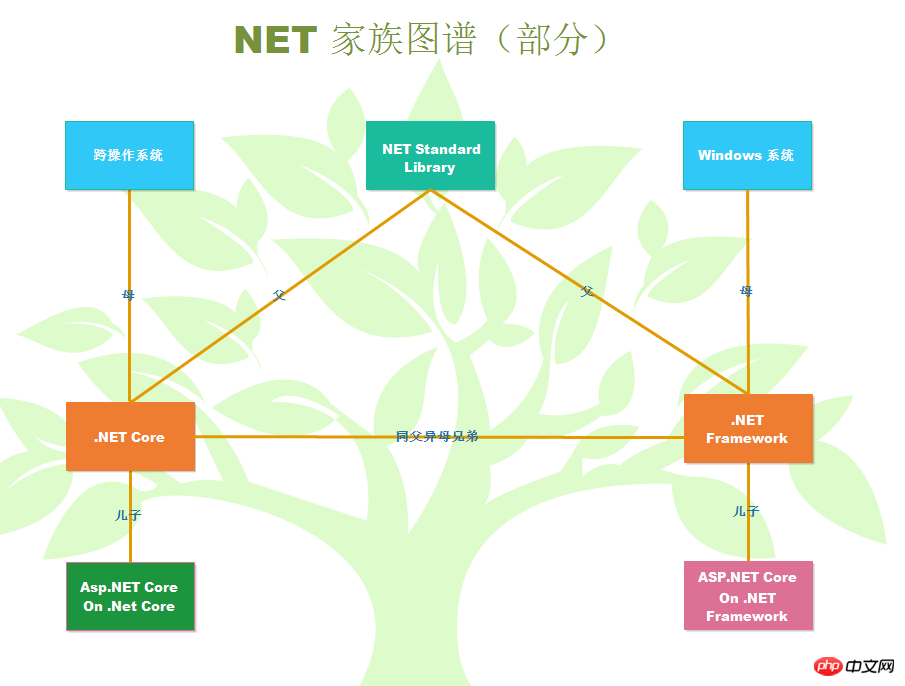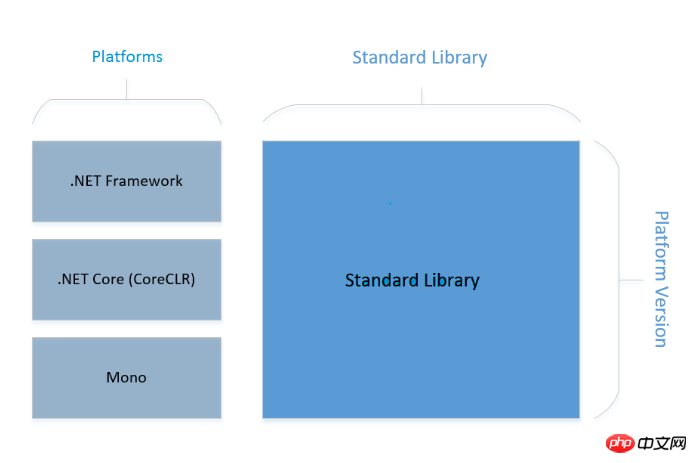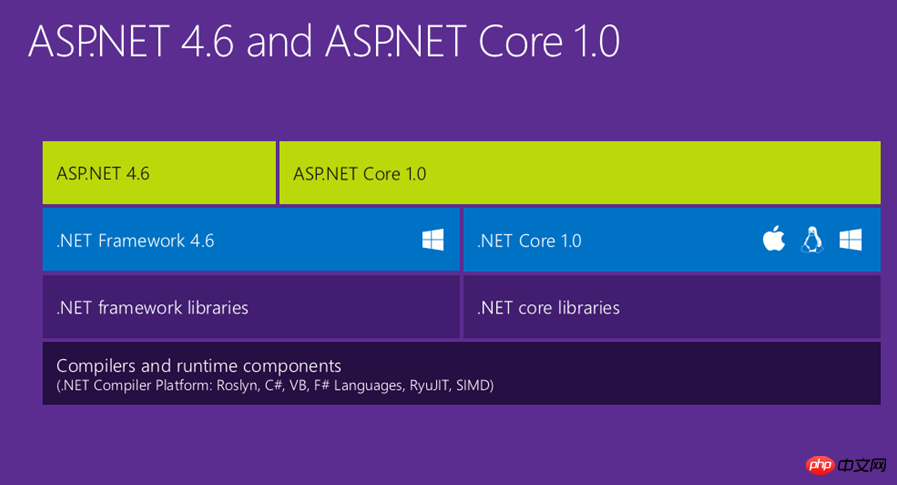 Backend Development
Backend Development
 C#.Net Tutorial
C#.Net Tutorial
 A brief analysis of .NET Core and a summary of its relationship with .NET Framework
A brief analysis of .NET Core and a summary of its relationship with .NET Framework
A brief analysis of .NET Core and a summary of its relationship with .NET Framework
It has been nearly 15 years since Microsoft launched the .NET platform in 2002. In the wave of rapid iteration of the Internet, many languages have been eliminated, and more new languages have emerged. However, .Net still stands firmly as a system development platform. In the first-line camp, and with the upcoming official A brief analysis of .NET Core and a summary of its relationship with .NET Framework of .NET Core (June 27, 2016), a new round of spring is bound to come.
1. NET Frameworks
To understand .NET Core, it is necessary to understand the many Frameworks of the previous .NET platform. In 2002, Microsoft released the first .NETFramework——.NET Framework, and soon after released the .NETCompact Framework for use on smaller mobile devices ( Windows mobile), and .NET Compact Framework also contains a system similar to .NET Framework (Runtime, Framework, Application Model), which is a simplified A brief analysis of .NET Core and a summary of its relationship with .NET Framework of .NET Framework. Over the past few years, Microsoft has continuously launched several frameworks similar to the .NET Framework to run on different devices and platforms. Each Framework has a similar system but not exactly the same, so there are more and more Frameworks. For developers, different devices need to maintain multiple sets of codes even if they have the same functions, which increases the complexity of development.

2. The arrival of .NET Core
Microsoft’s rethinking and improvement of these issues allowed .NET Core to emerge.
.NET Core is an open source modular Framework. Whether developing web or mobile devices, they all run under the same Framework (.NET Core), and .NET Core can also Runs on different operating systems, including Windows, linux, and MacOS, achieving cross-platform and cross-device functionality.
What’s even better is that .NET Core does not need to install the Framework in advance when publishing a program, but downloads it through Nuget. In this way, during the initial deployment, there is no need to install a complex and huge Framework, but according to Requires download. This Nuget-based on-demand loading makes .NET Core cross-platform.

.NET Core composition system is as follows:
1. Runtime
There are two types of RunTime implemented in .NET Core, NativeRuntime and CoreCLR. NativeRuntime converts C# or VB.net code directly into native machine code. CoreCLR is an open source JIT runtime that compiles the code into an intermediate language (IL) and then converts it into machine code at final runtime.
2. Unified BCL
Base Classlibrary is the basic class, such as FileSystem, Console, XML operations, etc.
3. Windows Store AppModel & A brief analysis of .NET Core and a summary of its relationship with .NET Framework Core 1.0
Provides a set of basic libraries for developing various touch screen devices and A brief analysis of .NET Core and a summary of its relationship with .NET Framework programs for Windows systems.
3 The relationship between .NET Core and other .NET Frameworks



A brief analysis of .NET Core and a summary of its relationship with .NET Framework Core Web Application(.NET Core)
A brief analysis of .NET Core and a summary of its relationship with .NET Framework, which relies on .NET Core, can only call .NET Core’s API and can run on multiple operating systems. (You can see the Reference Manager in the lower half of the picture below, there is no library in the .NET Framework in the assemblies)
A brief analysis of .NET Core and a summary of its relationship with .NET Framework Core Web Application (.NET Framework)
A brief analysis of .NET Core and a summary of its relationship with .NET Framework, which relies on .NET Core & .NET Framework, can call the API of .NET Core & .NET Framework and can only run under Windows. (You can see the Reference Manager in the upper part of the picture below, which contains all the libraries in the .NET Framework in the assemblies)

3 .NET Core & Mono
Mono is an implementation of the open source A brief analysis of .NET Core and a summary of its relationship with .NET Framework of the .NET Framework. It is very similar to .NET Core in some features, such as open source and cross-operating systems. At present, .NET CORE will learn from Mono's experience and develop and eventually be able to run better on other operating systems besides Windows. In addition, Mone supports more App Models than .NET Core (such as Windows Forms).
Summary
Microsoft CEO Satya Nadella wisely decided to abandon PC-centricity, embrace various devices and platforms, and become a software services company. In order to achieve this vision, a new Microsoft ecological chain must be built, including Windows, Linux, OS X and other operating systems, covering processors such as X86/ARM and different devices (including PCs, Phones, holographic glasses and others). These show Microsoft's "ambition". With the official release of .NET Core taking a solid step forward, let us wait and see on June 27.
The above is the detailed content of A brief analysis of .NET Core and a summary of its relationship with .NET Framework. For more information, please follow other related articles on the PHP Chinese website!

Hot AI Tools

Undresser.AI Undress
AI-powered app for creating realistic nude photos

AI Clothes Remover
Online AI tool for removing clothes from photos.

Undress AI Tool
Undress images for free

Clothoff.io
AI clothes remover

Video Face Swap
Swap faces in any video effortlessly with our completely free AI face swap tool!

Hot Article

Hot Tools

Notepad++7.3.1
Easy-to-use and free code editor

SublimeText3 Chinese version
Chinese version, very easy to use

Zend Studio 13.0.1
Powerful PHP integrated development environment

Dreamweaver CS6
Visual web development tools

SublimeText3 Mac version
God-level code editing software (SublimeText3)

Hot Topics
 What is the role of char in C strings
Apr 03, 2025 pm 03:15 PM
What is the role of char in C strings
Apr 03, 2025 pm 03:15 PM
In C, the char type is used in strings: 1. Store a single character; 2. Use an array to represent a string and end with a null terminator; 3. Operate through a string operation function; 4. Read or output a string from the keyboard.
 How to use various symbols in C language
Apr 03, 2025 pm 04:48 PM
How to use various symbols in C language
Apr 03, 2025 pm 04:48 PM
The usage methods of symbols in C language cover arithmetic, assignment, conditions, logic, bit operators, etc. Arithmetic operators are used for basic mathematical operations, assignment operators are used for assignment and addition, subtraction, multiplication and division assignment, condition operators are used for different operations according to conditions, logical operators are used for logical operations, bit operators are used for bit-level operations, and special constants are used to represent null pointers, end-of-file markers, and non-numeric values.
 How to handle special characters in C language
Apr 03, 2025 pm 03:18 PM
How to handle special characters in C language
Apr 03, 2025 pm 03:18 PM
In C language, special characters are processed through escape sequences, such as: \n represents line breaks. \t means tab character. Use escape sequences or character constants to represent special characters, such as char c = '\n'. Note that the backslash needs to be escaped twice. Different platforms and compilers may have different escape sequences, please consult the documentation.
 The difference between multithreading and asynchronous c#
Apr 03, 2025 pm 02:57 PM
The difference between multithreading and asynchronous c#
Apr 03, 2025 pm 02:57 PM
The difference between multithreading and asynchronous is that multithreading executes multiple threads at the same time, while asynchronously performs operations without blocking the current thread. Multithreading is used for compute-intensive tasks, while asynchronously is used for user interaction. The advantage of multi-threading is to improve computing performance, while the advantage of asynchronous is to not block UI threads. Choosing multithreading or asynchronous depends on the nature of the task: Computation-intensive tasks use multithreading, tasks that interact with external resources and need to keep UI responsiveness use asynchronous.
 The difference between char and wchar_t in C language
Apr 03, 2025 pm 03:09 PM
The difference between char and wchar_t in C language
Apr 03, 2025 pm 03:09 PM
In C language, the main difference between char and wchar_t is character encoding: char uses ASCII or extends ASCII, wchar_t uses Unicode; char takes up 1-2 bytes, wchar_t takes up 2-4 bytes; char is suitable for English text, wchar_t is suitable for multilingual text; char is widely supported, wchar_t depends on whether the compiler and operating system support Unicode; char is limited in character range, wchar_t has a larger character range, and special functions are used for arithmetic operations.
 How to convert char in C language
Apr 03, 2025 pm 03:21 PM
How to convert char in C language
Apr 03, 2025 pm 03:21 PM
In C language, char type conversion can be directly converted to another type by: casting: using casting characters. Automatic type conversion: When one type of data can accommodate another type of value, the compiler automatically converts it.
 What is the difference between char and unsigned char
Apr 03, 2025 pm 03:36 PM
What is the difference between char and unsigned char
Apr 03, 2025 pm 03:36 PM
char and unsigned char are two data types that store character data. The main difference is the way to deal with negative and positive numbers: value range: char signed (-128 to 127), and unsigned char unsigned (0 to 255). Negative number processing: char can store negative numbers, unsigned char cannot. Bit mode: char The highest bit represents the symbol, unsigned char Unsigned bit. Arithmetic operations: char and unsigned char are signed and unsigned types, and their arithmetic operations are different. Compatibility: char and unsigned char
 How to use char array in C language
Apr 03, 2025 pm 03:24 PM
How to use char array in C language
Apr 03, 2025 pm 03:24 PM
The char array stores character sequences in C language and is declared as char array_name[size]. The access element is passed through the subscript operator, and the element ends with the null terminator '\0', which represents the end point of the string. The C language provides a variety of string manipulation functions, such as strlen(), strcpy(), strcat() and strcmp().





